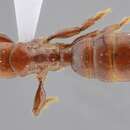en
names in breadcrumbs


Workers of this large ponerine are apparently entirely subterranean, and thus rarely encountered. In 1988 S. Cover (pers. comm.) observed closed turrets projecting from clay soil in open sunlit ground surrounding the River Station at La Selva Biological Station. Excavation yielded workers and males, and Cover suggested the turrets were the result of a premating flight excavation. Males are distinctively bicolored (figure: reduced, original), and have been collected at blacklights.
The genus Centromyrmex is pantropical, with three species in the Neotropics (Kempf 1966). Several species, and by extrapolation perhaps the entire genus, are specialized predators of termites, nesting within termite nests (Wheeler 1936, Luederwaldt 1926, Mann 1934, Borgmeier 1937, Kempf 1967, Levieux 1976, Mill 1982, Grasse 1986, Dejean and Feneron 1993, Delabie 1995). The biology of C. alfaroi in Costa Rica is unknown, but one can anticipate an association with termites. Delabie (1995) gives a detailed description of C. alfaroi populations in large soil mounds of Syntermes nests in the state of Bahia, Brazil. He found that C. alfaroi is polygynous, with many dealate queens occurring together with workers in termite mounds.
Costa Rica, Bolivia, Brazil (GO, SP, BA). Costa Rica: known from Alajuela, La Selva.
Taxonomic history
Emery, 1906c PDF: 115 (q.).[Also described as new by Emery, 1894l PDF: 46.].See also: Kempf, 1967b PDF: 404.